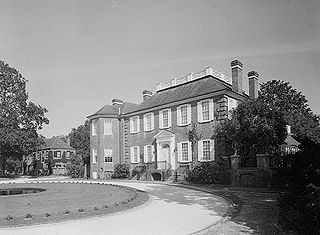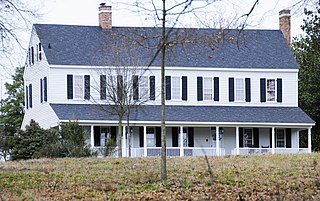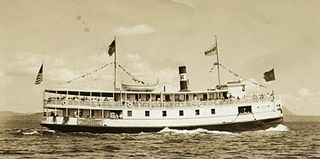
Greenville is a city and the county seat of Meriwether County, Georgia, United States. The population was 876 at the 2010 census. The city is located 54.9 miles (88.4 km) southwest of Atlanta and, as such, is part of the Atlanta metropolitan area.

The George Washington Birthplace National Monument is a national monument in Westmoreland County, Virginia, United States. This site was developed in the mid-17th century as a colonial tobacco plantation by Englishman John Washington. A member of the assembly, he was a great-grandfather of George Washington, general and the first United States president. George Washington was born in this house on February 22, 1732. He lived here until age three, returning later to live here as a teenager.

Arlington House, The Robert E. Lee Memorial, formerly named the Custis-Lee Mansion, is a Greek revival style mansion located in Arlington, Virginia, United States that was once the home of Confederate Army General Robert E. Lee. It overlooks the Potomac River and the National Mall in Washington, D.C. During the American Civil War, the grounds of the mansion were selected as the site of Arlington National Cemetery, in part to ensure that Lee would never again be able to return to his home. The United States has since designated the mansion as a National Memorial. Although the United States Department of the Army controls Arlington National Cemetery, the National Park Service, a component of the United States Department of the Interior, administers Arlington House.

Doughoregan Manor is a plantation house and estate located on Manor Lane west of Ellicott City, Maryland, United States. Established in the early 18th century as the seat of Maryland's prominent Carroll family, it was home to Charles Carroll, a signer of the United States Declaration of Independence, during the late 18th century. A portion of the estate, including the main house, was designated a National Historic Landmark on November 11, 1971. It remains in the Carroll family and is not open to the public.

Creagerstown is an unincorporated community in Frederick County, Maryland, United States. It is playfully known by its residents as "4 miles from everywhere" because of its situation at 4 miles (6.4 km) from Thurmont, Woodsboro, Rocky Ridge, and Lewistown.

The Fenwick Hall, which is also known as Fenwick Castle, is a plantation house built about 1730 on Johns Island, South Carolina, across the Stono River from James Island and Charleston. It is located between River Road and Penneys Creek. It was named to the National Register of Historic Places on February 23, 1972.

Holy Family Catholic Church is a historic Roman Catholic church in Wayne Township, Darke County, Ohio, United States. Located in the unincorporated community of Frenchtown, it houses an active congregation, and it has been accorded historic site status because of its well-preserved Gothic Revival architecture.

St. Paul's Episcopal Church is a historic Episcopal church at Old York and Ashbourne Roads in Elkins Park, Cheltenham Township, Montgomery County, Pennsylvania. It was originally built in 1861, and is a gray stone church in the Gothic style. The church was conceived by noted financier Jay Cooke (1821–1905), along with John W. Thomas, J.F. Peniston and William C. Houston. Its size was doubled with an expansion in 1870, and a 60-foot-tall tower added. A transept was added in 1883, and the two-story parish hall wing in 1891. Architect Horace Trumbauer (1868–1938) made some refinements to the church during the 1897 to 1924 period. The main sanctuary of the church features 13 stained glass windows from Tiffany studios.

Greenville Presbyterian Church is a historic Presbyterian church located near Donalds, Greenwood County, South Carolina. It was built in 1852 and is a meeting house form, Greek Revival style brick church. Also on the property are a small brick Session House, a large historic cemetery containing about 1,200 identifiable graves, and a natural spring. The earliest graves in the church cemetery date from 1777 and numerous markers indicate service in the American Revolution and American Civil War.

Miller–Pence Farm is a historic home and farm located near Greenville, Monroe County, West Virginia. The main farmhouse was built in 1828, with five modifications through 1910. It began as a two-story Federal style brick home on a coursed rubble foundation. A two-story addition dated to the 1880s, with a cut stone foundation, has board-and-batten siding, evoking the Carpenter Gothic architectural style. Also on the property are a former slave school, second school, three barns, tractor shed, equipment shed, corn crib and ruins of Miller's Frontier House, spring box, original road cut, and the Miller-Halstead Cemetery.

The William Bates House is located on South Carolina Highway 14 in Greenville County near Greenville, South Carolina. The two-story vernacular structure was built ca1835 for William Bates, a pioneer in the textile industry, who founded Batesville Cotton Mill. It is believed that the house is the only remaining structure associated with William Bates.

The John H. Goodwin House, also known as the Blythe-Goodwin-Hagood House is a historic structure located on South Carolina Highway 11 in Greenville County near Travelers Rest, South Carolina. The two-story farmhouse and the one-story store building located in front of the house are listed on the National Register of Historic Places.

The George Salmon House, also known as the C. Douglas Wilson Farm, is located near Travelers Rest, South Carolina on SC Highway 414, off of US Highway 25.

The Hopkins Farm is an agricultural complex listed on the National Register of Historic Places located near the intersection of South Carolina Highway 418 and Fork Shoals Road in the vicinity of Simpsonville, South Carolina. The complex, begun by John Hopkins who purchased the land in 1834 from James Harrison, consists of the main house, a cook's house, agricultural fields, a pecan grove, eleven outbuildings and a family cemetery.

Woodside Cotton Mill Village Historic District is a national historic district located in Greenville County, South Carolina. The district encompasses 278 contributing buildings and 2 contributing sites in an early 20th century urban South Carolina textile mill village. Centered on a mill founded by John T. Woodside in 1902, the district is located just west of the city limits of Greenville and is largely intact despite modernizations made by a succession of mill and home owners. The mill itself is a rectangular, brick, four-story building designed by J.E. Sirrine and built between 1902 and 1912. Eventually the mill became the largest cotton mill under one roof in the United States and one of the largest in the world.

Cureton House is a historic home located near Lancaster, Lancaster County, South Carolina. It was built about 1840, and is a two-story, L-shaped, frame Greek Revival style residence. It is sheathed in clapboard siding and has cross-gable roof and brick pier foundation. The house has a central hall plan and two rooms in the rear ell. Also on the property is a cotton storage shed, barn, and garage.

The Katahdin is a historic steamboat berthed on Moosehead Lake in Greenville, Maine. Built in 1914 at the Bath Iron Works, it at first served the tourist trade on the lake before being converted to a towboat hauling lumber. It was fully restored in the 1990s by the nonprofit Moosehead Maritime Museum, and is again giving tours on the lake. One of the very few surviving early lake boats in Maine, and the oldest vessel afloat built at Bath, it was listed on the National Register of Historic Places in 1978.



















